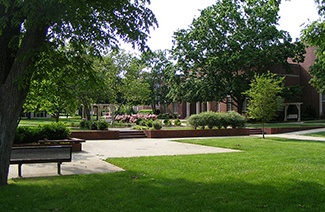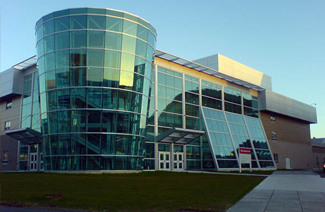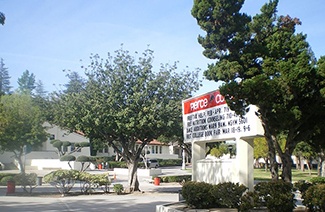| flourish v. 繁荣 | initiate v. 开始 | sufficient adj. 足够的,充分的 |
| inhibit v. 阻止 | substantially 相当多的 | harsh adj. 严酷的,粗糙的 |
| exploit v. 利用 | drawn to 被…吸引 | apparently=certainly adv. 显然地 |
| radical adj. 激烈的,激进的 |
第一篇:
版本一:讲某个部落的人迁徙到一个新的地方。他们即是游牧的,但又会种植作物。但是最后不得不迁徙,因为人太多了。wild animal和作物都不够吃。
版本二:climate对N族人的影响 他们开始更大范围的hunt 种grain之类的
版本三:
一个人种(囧)在younger dryra年代的生活 【编者注:此处人种经查找很可能为“Natufian”】
一开始说因为河流和水源渐渐干涸,猎物(game)也随之越来越少(此处有题),所以人们需要更精湛的捕猎技巧,也因为这个发明了一种新的arrowhead(有题)。
后来呢他们捕不到足够的猎物了就settled了,开始cultivated rye crop, 把野生的rye慢慢“驯化”了。考古学家还在一个村子里发现了公元前11100-11020的rye,这是最早的人工培育rye。
但是呢,cultivated rye也不能满足需求啊,所以他们又变回游牧了,然后domestic rye又变wild了(有题)。
最后一段说他们后来因为水源干涸放弃了祖先生活的woodland,改而搬迁到更富饶的约旦河边(jordan river)。哦这里也有题。
解析:历史题材文章结构为时间顺序,故而逻辑性较少,属于直线型文章。读文章时光看首句不一定能概括全段,需通过题目进行段意还原。而且还要多考虑各段之间的关系。
相关背景:
Younger Dryas
From Wikipedia, the free encyclopedia
Three temperature proxies showing the Younger Dryas event at around 12 ka BP. The NGRIP sequence (red – mislabelled as GRIP) uses the water molecule isotopic composition – δ18O. The Vostok and EPICA Dome C series show delta-deuterium. All 3 proxies use the same vertical axis.
The Younger Dryas stadial, also referred to as the Big Freeze, was a geologically brief (1,300 ± 70 years) period of cold climatic conditions and drought which occurred between approximately 12,800 and 11,500 years BP. The Younger Dryas stadial is thought to have been caused by the collapse of the North American ice sheets, although rival theories have been proposed.
It followed the Bølling-Allerød interstadial (warm period) at the end of the Pleistocene and preceded the preboreal of the early Holocene. It is named after an indicator genus, the alpine-tundra wildflower Dryas octopetala. In Ireland, the period has been known as the Nahanagan Stadial, while in the United Kingdom it has been called the Loch Lomond Stadial and most recently Greenland Stadial 1 (GS1). The Younger Dryas (GS1) is also a Blytt-Sernander climate period detected from layers in north European bog peat.
The Dryas stadials were cold periods which interrupted the warming trend since the Last Glacial Maximum 20,000 years ago. The Older Dryas occurred approximately 1,000 years before the Younger Dryas and lasted about 3000 years. The Oldest Dryas is dated between approximately 18,000 and 15,000 BP.
The Younger Dryas, an intense cooling and drying event of global proportions, has been attributed a major causal role in the adoption of agricultural economies in the southern Levant. Here, the impact of the Younger Dryas on human adaptations is evaluated using a small game index that measures the efficiency of human foraging as a proxy for site occupation intensity. The study examines faunal assemblages spanning the agricultural transition and dating to the Early and Late Natufian and Pre-Pottery Neolithic periods (ca. 14,500 to 11,000 Cal. BP). The small game index and other supporting evidence document major fluctuations in human site occupation intensity across this critical phase. Site occupation reached an unprecedented high during the Early Natufian, but quickly reverted to pre-Natufian levels with the onset of the Younger Dryas in the Late Natufian phase. By decreasing site occupation intensity and increasing mobility, the Late Natufians implemented effective demographic strategies to cope with changing resource distributions. In contrast, there is no evidence for intensified resource use or food stress in the Late Natufian, at least in comparison to the Early Natufian phase. Although, it is tempting to assign the Younger Dryas a causal role in the adoption of agricultural economies, support for this hypothesis (in the form of food stress and resource intensification) does not currently exist.
Natufian culture
The Natufian culture /nəˈtjuːfiən/ was an Epipaleolithic culture that existed from 13,000 to 9,800 B.C. in the Levant, a region in the Eastern Mediterranean. It was unusual in that it was sedentary, or semi-sedentary, before the introduction of agriculture. The Natufian communities are possibly the ancestors of the builders of the first Neolithic settlements of the region, which may have been the earliest in the world. There is some evidence for the deliberate cultivation of cereals, specifically rye, by the Natufian culture, at the Tell Abu Hureyra site, the site for earliest evidence of agriculture in the world. Generally, though, Natufians made use of wild cereals. Animals hunted included gazelles.
The term "Natufian" was coined by Dorothy Garrod who studied the Shuqba cave in Wadi an-Natuf, in the western Judean Mountains, about halfway between Tel Aviv and Ramallah.
Settlements
Remains of a wall of a Natufian house
Settlements occur in the woodland belt where oak and Pistacia species dominated. The underbrush of this open woodland was grass with high frequencies of grain. The high mountains of Lebanon and the Anti-Lebanon, the steppe areas of the Negev desert in Israel and Sinai, and the Syro-Arabian desert in the east were much less favoured for Natufian settlement, presumably due to both their lower carrying capacity and the company of other groups of foragers who exploited this region.
The habitations of the Natufian are semi-subterranean, often with a dry-stone foundation. The superstructure was probably made of brushwood. No traces of mudbrick have been found, which became common in the following Pre-Pottery Neolithic A (PPNA). The round houses have a diameter between three and six meters, and they contain a central round or subrectangular fireplace. In Ain Mallaha traces of postholes have been identified. "Villages" can cover over 1,000 square meters. Smaller settlements have been interpreted by some researchers as camps. Traces of rebuilding in almost all excavated settlements seem to point to a frequent relocation, indicating a temporary abandonment of the settlement. Settlements have been estimated to house 100–150, but there are three categories: small, median, and large, ranging from 15 sq. m to 1,000 sq. m of people. There are no definite indications of storage facilities.
Sedentism
A semi-sedentary life may have been made possible by abundant resources due to a favourable climate at the time, with a culture living from hunting, fishing and gathering, including the use of wild cereals. Tools were available for making use of cereals: flint-bladed sickles for harvesting, and mortars, grinding stones, and storage pits.
Development of agriculture
According to one theory, it was a sudden change in climate, the Younger Dryas event (ca. 10,800 to 9500 BC), that inspired the development of agriculture. The Younger Dryas was a 1,000-year-long interruption in the higher temperatures prevailing since the Last Glacial Maximum, which produced a sudden drought in the Levant. This would have endangered the wild cereals, which could no longer compete with dryland scrub, but upon which the population had become dependent to sustain a relatively large sedentary population. By artificially clearing scrub and planting seeds obtained from elsewhere, they began to practice agriculture. However, this theory of the origin of agriculture is controversial in the scientific community.#p#副标题#e#
第二篇:
版本一:M什么的cycle从larva到adult 有的larva也会不到adult
版本二:metamorphosis,有frog 和butterfly 的例子。
文章開始說這種類型的生物挑選不同的niche 在不同的變態時期有困難。後來提到adult 有為後代挑選habitat 的義務。有些時候adult 吃是為了繁殖的需要。還有些物種變態到一個時期就不繼續變態了,就是不進化到adult,然而他們已經成熟到可以繁殖了。當然這些發生在比較極端的環境,像什麼高海拔什麼的
版本三:
Metamorphosis(变态的两栖动物)
第一段说变态就是juvenile变成pupil,这过程中会有一个protection,可能会花费几个小时或几天。然后又从pupil花几天变成成虫。(这里有题)青蛙会从蝌蚪(tadpole)变成青蛙,蝴蝶会从毛毛虫(larva,复数larvae)变成蝴蝶,这就是变态(囧)。
第二段介绍了变态的优缺点,优点是可以有效地分配自己的life cycle,应对不同时期的不同环境。缺点是变态需要很详细的规划,而且会消耗大量能量。那么为什么还要选择变态这种方式呢?(这里有题,问写这句话的目的是什么)
第三段说青蛙的变态,因为青蛙的卵是在 比较恶劣的条件下诞生的,所以青蛙会把自己的体力大部分消耗在繁殖和产卵这部分life cycle上。
第四段说蝴蝶其实也是这样,不赘述了。
第五段说还有一些在好一点条件下诞生的卵会在juvenile阶段就sexual mature而且不再变成成熟形态。
最后一段就说什么情况下生物会选择metamorphosis呢?如果juvenile阶段的环境不好,那就很可能会选择metamorphosis。
解析:
标题出现术语时不要紧张,第一段一定会有相应概念解说。需要通读首段和其余各段首句后进行解题,避免造成一知半解,文章结构不清等状况。
相关背景:
Metamorphosis
Metamorphosis is a biological process by which an animal physically develops after birth or hatching, involving a conspicuous and relatively abrupt change in the animal's body structure through cell growth and differentiation. Some insects, amphibians, molluscs, crustaceans, cnidarians, echinoderms and tunicates undergo metamorphosis, which is usually accompanied by a change of habitat or behavior.
Scientific usage of the term is exclusive, and is not applied to general aspects of cell growth, including rapid growth spurts. References to "metamorphosis" in mammals are imprecise and only colloquial, but historically idealist ideas of transformation and monadology, as in Goethe's Metamorphosis of Plants, influenced the development of ideas of evolution.
A. Frogs and toads
With frogs and toads, the external gills of the newly hatched tadpole are covered with a gill sac after a few days, and lungs are quickly formed. Front legs are formed under the gill sac, and hindlegs are visible a few days later. Following that there is usually a longer stage during which the tadpole lives off a vegetarian diet. Tadpoles use a relatively long, spiral‐shaped gut to digest that diet.
Rapid changes in the body can then be observed as the lifestyle of the frog changes completely. The spiral‐shaped mouth with horny tooth ridges is resorbed together with the spiral gut. The animal develops a big jaw, and its gills disappear along with its gill sac. Eyes and legs grow quickly, a tongue is formed, and all this is accompanied by associated changes in the neural networks (development of stereoscopic vision, loss of the lateral line system, etc.) All this can happen in about a day, so it is truly a metamorphosis. It isn't until a few days later that the tail is reabsorbed, due to the higher thyroxin concentrations required for tail resorption.
B. Butterflies
How does a caterpillar become a Moth or a Butterfly?
The answer to that can actually get quite complicated but basically what happens is this. When the caterpillar has eaten enough it turns into a pupa, more about this later on because it is different for different groups of Lepidoptera. To do this it stops eating and finds somewhere safe, here it becomes very still (pupa never eat and seldomly move at all) it then moults its skin the same as it does when it is growing only instead of another larval skin it secretes a pupal skin, (inside its old larval skin) that is much thicker and stronger. Generally this pupa then breaks out of the old larval skin, though in many moths the pupa remains inside the old larval skin, you can often find the remains of the caterpillar skin around the tail of a Butterfly pupa. All that is fairly straight forward, where it gets tricky is how the caterpillar inside its new pupal case changes itself into a Butterfly or Moth. The first thing that happens is that a lot of the caterpillars old body dies. It is attacked by the same sort of juices the caterpillar used in its earlier life to digest its food, it would not be far wrong to say the caterpillar digests itself from the inside out, this process is called "histolysis". Not all the tissue is destroyed however some of the insects old tissue passes on to its new self, the amount that does this varies between different insects, and is not very much in the Lepidoptera. There is one particular sort of tissue left, in a number of places in the insects body are collections of special formative cells, which have played no part in the insects larval life, and have stayed hidden or protected during this partial death, each of these groups of cells is called an "imaginal bud" or a "histoblast". The job of these histoblasts is to supervise the building of a new body out of the soup that the insects digestive juices have made of the old larval body. This they do using the same biochemical processes that all insects use to turn their food into part of their bodies. This rebuilding process is called "histogenesis". During this time the insect is very vulnerable because it cannot run away, and this is why insects try to choose somewhere safe to hide away when they are going through this incredible change, still I think you have to be very brave to be a Caterpillar and become a Butterfly or a Moth.
Larva
A larva (plural larvae /ˈlɑrviː/) is a distinct juvenile form many animals undergo before metamorphosis into adults. Animals with indirect development such as insects, amphibians, or cnidarians typically have a larval phase of their life cycle.
The larva's appearance is generally very different from the adult form (e.g. caterpillars and butterflies). A larva often has unique structures and organs that do not occur in the adult form, while their diet might be considerably different.
Larvae are frequently adapted to environments separate from adults. For example, some larvae such as tadpoles live exclusively in aquatic environments, but can live outside water as adult frogs. By living in a distinct environment, larvae may be given shelter from predators and reduce competition for resources with the adult population.
Animals in the larval stage will consume food to fuel their transition into the adult form. Some species such as barnacles are immobile as adults, and use their mobile larval form to distribute themselves.
It is a misunderstanding that the larval form always reflects the group's evolutionary history. This could be the case, but often the larval stage has evolved secondarily, as in insects. In these cases the larval form may differ more than the adult form from the group's common origin.#p#副标题#e#
第三篇:
版本一:讲三种海洋reef的形成。这篇阅读是关于coral reef的 有三种类型atoll、fringe、和barrier reef。文章重点讨论atoll 因为它在非常深的水底生长 并且会包围一片水域成为lagoon 文章主要讨论了atoll形成的原因,解释是达尔文提出的一个理论:A其实是由F形成的。,后来虽然被科学家怀疑,但不久后的发现又证实了达尔文是对的。
版本二:
珊瑚礁(重点讲atoll(环礁)这个种类)
第一段说珊瑚礁有三种,atoll,barrier reef(堡礁) 和 fringing reef(岸礁)。atoll主要在印度洋附近,里面有大大的lagoon。barrier reef和fringing reef就哪里都有了。
第二段说根据达尔文的猜想,atoll说长在volcanic island上的fringing reef由于海水沉积放慢,所以慢慢形成barrier reef,最后形成了fringing reef。也解释了lagoon怎么产生的。虽然这可以解释三种coral的进化关系,但是并不能解释所有barrier reef和fringing reef的形成。
第三段说很多科学家质疑达尔文的猜想,但是一个科学家钻了3000miles的limestone然后发现了一个在volcanic island上面的atoll layer,证实了darwin的想法是对的。
第四段又重申这不能解释所有barrier reef 和 fringing reef的形成。
最后一段说在很多沉积很快的ocean里是不会积成atoll的。
解析:
相关背景:
Atoll
Formation
See also: Formation of coral reefs
In 1842, Darwin explained the creation of coral atolls in the southern Pacific Ocean based upon observations made during a five-year voyage aboard the HMS Beagle from 1831 to 1836. Accepted as basically correct, his explanation involved considering that several tropical island types—from high volcanic island, through barrier reef island, to atoll—represented a sequence of gradual subsidence of what started as an oceanic volcano. He reasoned that a fringing coral reef surrounding a volcanic island in the tropical sea will grow upwards as the island subsides (sinks), becoming an "almost atoll", or barrier reef island, as typified by an island such as Aitutaki in the Cook Islands, Bora Bora and others in the Society Islands. The fringing reef becomes a barrier reef for the reason that the outer part of the reef maintains itself near sea level through biotic growth, while the inner part of the reef falls behind, becoming a lagoon because conditions are less favorable for the coral and calcareous algae responsible for most reef growth. In time, subsidence carries the old volcano below the ocean surface and the barrier reef remains. At this point, the island has become an atoll.
Atolls are the product of the growth of tropical marine organisms, and so these islands are only found in warm tropical waters. Volcanic islands located beyond the warm water temperature requirements of hermatypic (reef-building) organisms become seamounts as they subside and are eroded away at the surface. An island that is located where the ocean water temperatures are just sufficiently warm for upward reef growth to keep pace with the rate of subsidence is said to be at the Darwin Point. Islands in colder, more polar regions evolve towards seamounts or guyots; warmer, more equatorial islands evolve towards atolls, for example Kure Atoll.
Reginald Aldworth Daly offered a somewhat different explanation for atoll formation: islands worn away by erosion, by ocean waves and streams, during the last glacial stand of the sea of some 900 feet (270 m) below present sea level developed as coral islands (atolls), or barrier reefs on a platform surrounding a volcanic island not completely worn away, as sea level gradually rose from melting of the glaciers. Discovery of the great depth of the volcanic remnant beneath many atolls such as at Midway Atoll favors the Darwin explanation, although there can be little doubt that fluctuating sea level has had considerable influence on atolls and other reefs.
Coral atolls are also an important place where dolomitization of calcite occurs. At certain depths water is undersaturated in calcium carbonate but saturated in dolomite. Convection created by tides and sea currents enhance this change. Hydrothermal currents created by volcanoes under the atoll may also play an important role.
Coral Reef
Coral reefs are underwater structures made from calcium carbonate secreted by corals. Coral reefs are colonies of tiny animals found in marine waters that contain few nutrients. Most coral reefs are built from stony corals, which in turn consist of polyps that cluster in
groups. The polyps belong to a group of animals known as Cnidaria, which also includes sea anemones and jellyfish. Unlike sea anemones, coral polyps secrete hard carbonate exoskeletons which support and protect their bodies. Reefs grow best in warm, shallow, clear, sunny and agitated waters.
Often called "rainforests of the sea", coral reefs form some of the most diverse ecosystems on Earth. They occupy less than 0.1% of the world's ocean surface, about half the area of France, yet they provide a home for 25% of all marine species, including fish, mollusks, worms, crustaceans, echinoderms, sponges, tunicates and other cnidarians. Paradoxically, coral reefs flourish even though they are surrounded by ocean waters that provide few nutrients. They are most commonly found at shallow depths in tropical waters, but deep water and cold water corals also exist on smaller scales in other areas.
Lagoons
Lagoons are shallow, often elongated bodies of water separated from a larger body of water by a shallow or exposed shoal, coral reef, or similar feature. Some authorities (such as Nybakken) include fresh water bodies in the definition of "lagoon", while others explicitly restrict "lagoon" to bodies of water with some degree of salinity. The distinction between "lagoon" and "estuary" also varies between authorities. Richard A. Davis Jr. restricts "lagoon" to bodies of water with little or no fresh water inflow, and little or no tidal flow, and calls any bay that receives a regular flow of fresh water an "estuary". Davis does state that the terms "lagoon" and "estuary" are "often loosely applied, even in scientific literature." Kusky characterizes lagoons as normally being elongated parallel to the coast, while estuaries are usually drowned river valleys, elongated perpendicular to the coast. When used within the context of a distinctive portion of coral reef ecosystems, the term "lagoon" is synonymous with the term "back reef" or "backreef", which is more commonly used by coral reef scientists to refer to the same area. Coastal lagoons are classified as inland bodies of water.
















